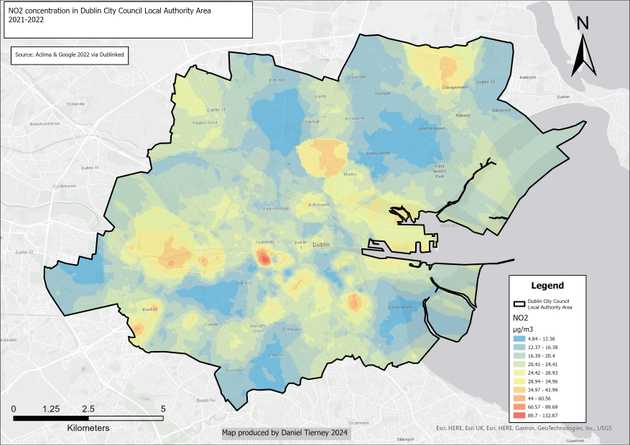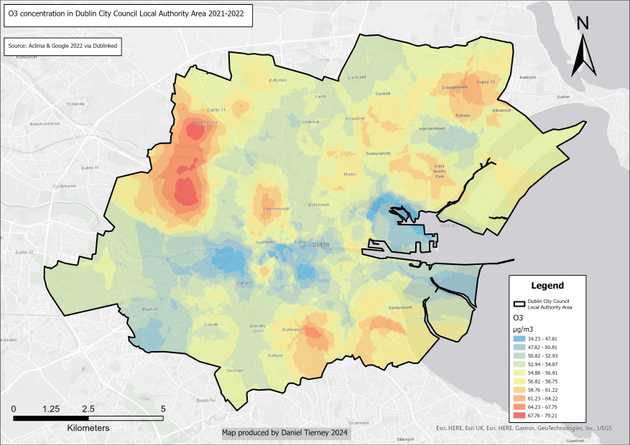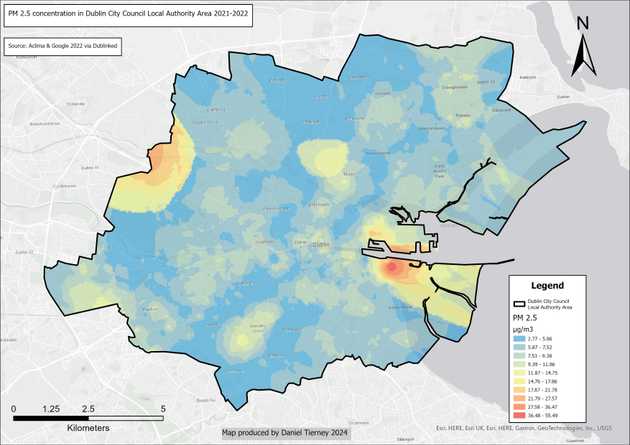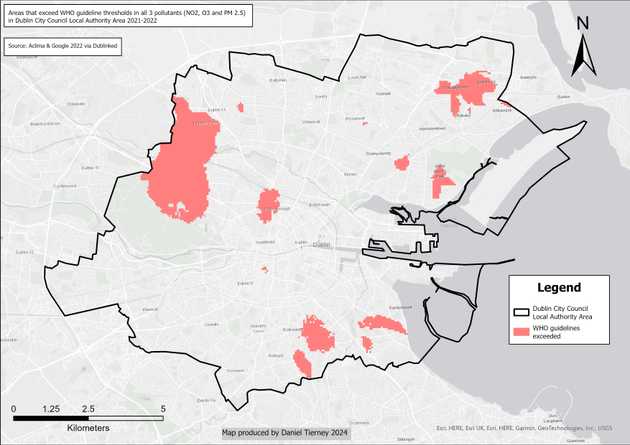Every day, Dubliners breathe in the invisible mix of gases and particles that make up our city's air. While we can't see most pollutants, their effects on our health are very real. How can we understand something we can't see? This is where GIS technology offers a powerful solution.
I recently analysed air quality data collected by Google Street View cars as they drove around Dublin, capturing pollution readings at street level. The result? A detailed picture of how air pollution varies across the city, revealing hotspots and patterns invisible to the naked eye.
The Innovation: Street-Level Pollution Mapping
Traditional air quality monitoring relies on a handful of fixed stations scattered across a city. While accurate, these stations can't capture the block-by-block variations that affect our daily exposure to pollutants.
Enter Project Air View – a collaboration between Google and Dublin City Council. From May 2021 to August 2022, electric Google Street View cars equipped with Aclima's air sensing technology cruised Dublin's streets, collecting measurements of key pollutants at unprecedented spatial resolution.
This project comes at a critical time, as Dublin implements its Air Quality Plan 2021 and aligns with the World Health Organization's updated 2021 guidelines, which significantly tightened acceptable pollution thresholds based on new evidence of health impacts.
Turning Data Points into Continuous Maps
The raw data from the Google Street View cars came as thousands of point measurements scattered across Dublin's road network. To transform these into comprehensive maps, I followed these steps:
-
Data Preparation: I imported the CSV dataset into ArcGIS Pro, plotting each measurement using its latitude and longitude coordinates.
-
Pollutant Selection: After reviewing the available measurements, I focused on three critical pollutants:
- Nitrogen Dioxide (NO₂): A gas primarily from vehicle exhaust that irritates airways
- Particulate Matter (PM2.5): Tiny particles that can penetrate deep into lungs and even enter the bloodstream
- Ground-level Ozone (O₃): A reactive gas formed when other pollutants interact with sunlight
-
Spatial Interpolation: Here's where the GIS magic happens. I used Empirical Bayesian Kriging (EBK) to estimate pollution levels between measurement points. Unlike simpler interpolation methods, EBK accounts for uncertainty in the spatial model, making it particularly suitable for environmental data where underlying factors can be complex and variable.
-
Classification Method: Initially, I classified the data according to the EPA's Air Quality Index for Health. However, this showed little variation across the city as most areas fell within the lower categories. To better highlight localised patterns, I switched to Jenks Natural Breaks classification, which optimises class boundaries to maximise the differences between groups.
-
Threshold Analysis: Using the raster calculator, I identified areas where pollutant levels exceeded the WHO's 2021 guideline thresholds, creating a composite map of critical hotspots.
Dublin's Pollution Landscape: What the Maps Reveal
Nitrogen Dioxide (NO₂): Traffic Corridors Stand Out
 Figure 1: Nitrogen dioxide concentration in Dublin. The Naas Road area, Drumcondra and Bridge Street Upper show higher levels compared to the rest of the city.
Figure 1: Nitrogen dioxide concentration in Dublin. The Naas Road area, Drumcondra and Bridge Street Upper show higher levels compared to the rest of the city.
NO₂ concentrations closely follow Dublin's major traffic arteries. The highest levels appear along:
- The Naas Road corridor, a major commuter route into the city centre
- Drumcondra, particularly near the junction with the M1 motorway
- Bridge Street Upper and the approaches to the city centre
These patterns reflect NO₂'s primary source: vehicle exhaust. The pollutant concentrates along congested routes and dissipates as you move away from busy roads.
Ozone (O₃): A Different Pattern Emerges
 Figure 2: Ozone concentration in Dublin. The Navan Road area, Finglas West, North Circular Road, Ranelagh/Rathmines, and Shrewsbury Road/Merrion Road (D4) show comparatively high levels.
Figure 2: Ozone concentration in Dublin. The Navan Road area, Finglas West, North Circular Road, Ranelagh/Rathmines, and Shrewsbury Road/Merrion Road (D4) show comparatively high levels.
Interestingly, O₃ shows a somewhat different spatial pattern. Higher concentrations appear in:
- Navan Road area
- Finglas West
- Parts of the North Circular Road
- Ranelagh and Rathmines
- The affluent Shrewsbury Road/Merrion Road area in Dublin 4
This reflects ozone's complex formation process. Unlike primary pollutants emitted directly from sources, ozone forms through chemical reactions between nitrogen oxides and volatile organic compounds in the presence of sunlight. Sometimes, ozone levels can be lower in areas with high NO₂ due to chemical interactions that consume ozone.
Particulate Matter (PM2.5): Industrial Influence
 Figure 3: Particulate Matter (PM2.5) concentration in Dublin. Ashtown Road, Irishtown and Dublin Port are most notable for high levels.
Figure 3: Particulate Matter (PM2.5) concentration in Dublin. Ashtown Road, Irishtown and Dublin Port are most notable for high levels.
PM2.5 concentrations highlight different sources:
- The Dublin Port area shows notably high levels, likely reflecting industrial activities and shipping emissions
- Irishtown, adjacent to the former Poolbeg generating station, shows elevated concentrations
- Ashtown Road area also displays higher PM2.5 levels
Unlike NO₂, which comes primarily from traffic, PM2.5 has diverse sources including industrial processes, construction, residential heating (particularly solid fuels like peat and coal), and traffic. The port area's high concentrations suggest industrial sources contribute significantly to Dublin's particulate pollution.
Critical Hotspots: Where Multiple Pollutants Coincide
 Figure 4: Areas in Dublin that exceed WHO guideline thresholds in all three pollutants (Red) - Finglas West, Phibsborough, Donaghmede in the north and Ranelagh, Sandymount, Palmerstown and Donnybrook in the south.
Figure 4: Areas in Dublin that exceed WHO guideline thresholds in all three pollutants (Red) - Finglas West, Phibsborough, Donaghmede in the north and Ranelagh, Sandymount, Palmerstown and Donnybrook in the south.
The most concerning areas are those where all three pollutants exceed WHO guideline thresholds. These hotspots include:
- Northern areas: Finglas West, Phibsborough, and Donaghmede
- Southern areas: Ranelagh, Sandymount, Palmerstown, and Donnybrook
Interestingly, these areas span different socioeconomic profiles, from working-class neighbourhoods to some of Dublin's most affluent suburbs. Air pollution crosses social boundaries, though the resources to mitigate its effects may not be equally distributed.
Health Implications and Solutions
The patterns revealed in these maps matter because they directly impact public health. NO₂ exposure is linked to respiratory conditions and can exacerbate asthma. PM2.5 can penetrate deep into the lungs and bloodstream, increasing the risk of heart attacks, strokes, and respiratory diseases. Ground-level ozone irritates the respiratory system and can reduce lung function, particularly during outdoor activities.
Based on the spatial patterns identified, several targeted interventions could help improve Dublin's air quality:
1. Green Infrastructure Expansion
The maps highlight areas that would benefit most from increased vegetation. Trees and plants can help filter NO₂ and particulate matter, while also providing cooling effects that may reduce ozone formation.
Barcelona's "Superblocks" programme offers an inspiring model, transforming street grids into pedestrian-friendly areas with increased vegetation. Similar interventions in Dublin's pollution hotspots could dramatically improve local air quality while creating more liveable neighbourhoods.
2. Traffic Management in Key Corridors
With NO₂ concentrations closely following major traffic routes, targeted measures along these corridors could have significant impacts:
- Low Emission Zones (LEZs) in areas exceeding WHO thresholds
- Traffic calming measures to reduce congestion
- Priority bus lanes and cycling infrastructure to encourage modal shift
Berlin and Milan have demonstrated that LEZs can reduce NO₂ concentrations by 10-15% in targeted areas. The National Transport Authority's BusConnects programme is already working to improve public transport infrastructure in Dublin, which could support these efforts.
3. Port and Industrial Emissions Control
The high PM2.5 concentrations around Dublin Port suggest that industrial sources require attention. Stricter emissions standards, shore power for docked ships, and modernised equipment could significantly reduce particulate pollution in eastern Dublin.
4. Residential Heating Improvements
Although not explicitly mapped in this analysis, residential solid fuel burning contributes to particulate pollution, particularly in winter. The SEAI (Sustainable Energy Authority of Ireland) offers grants for home energy upgrades that could help address this source in areas with high PM2.5 levels through their Better Energy Homes scheme.
Looking Forward: The Next Steps for Dublin's Air
This analysis demonstrates the power of high-resolution spatial data in understanding urban environmental challenges. The patterns revealed can help target interventions where they'll have the greatest impact on both air quality and public health.
Future analyses could build on this work by:
- Incorporating seasonal variations to understand how pollution patterns change throughout the year
- Analysing demographic data alongside pollution levels to identify vulnerable populations
- Monitoring changes as Dublin implements its Air Quality Plan 2021
- Exploring correlations with health data to quantify local impacts
As Dublin continues to grow and develop, maintaining this detailed understanding of air quality will be essential for creating a healthier, more sustainable city. The invisible has been made visible through GIS – now we can use this knowledge to breathe easier.
For those interested in learning more about Dublin's air quality initiatives or accessing real-time air quality data, visit the EPA's Air Quality Index for Health website at airquality.ie.
Data Source
The analysis in this post uses data from Google Project Air View (2022) 'Dublin City Measurements CSV', available through data.gov.ie. This innovative data collection project, a collaboration between Google and Dublin City Council, provided street-level air quality measurements across Dublin from May 2021 to August 2022.
